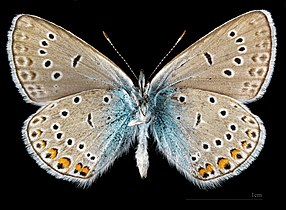
The common blue butterfly or European common blue is a butterfly in the family Lycaenidae and subfamily Polyommatinae. The butterfly is found throughout the Palearctic. Butterflies in the Polyommatinae are collectively called blues, from the coloring of the wings. Common blue males usually have wings that are blue above with a black-brown border and a white fringe. The females are usually brown above with a blue dusting and orange spots.

The green hairstreak is a small butterfly in the family Lycaenidae.

The chalkhill blue is a butterfly in the family Lycaenidae. It is a small butterfly that can be found throughout the Palearctic realm, where it occurs primarily in grasslands rich in chalk. Males have a pale blue colour, while females are brown. Both have chequered fringes around their wings.

The Adonis blue is a butterfly in the family Lycaenidae. It inhabits the Palearctic realm.

Cyaniris semiargus, the Mazarine blue, is a Palearctic butterfly in the family Lycaenidae.

Papilio clytia, the common mime, is a swallowtail butterfly found in south and southeast Asia. The butterfly belongs to the subgenus Chilasa, the black-bodied swallowtails. It serves as an excellent example of a Batesian mimic among the Indian butterflies.

The purple-shot copper is a butterfly in the family of the Lycaenidae or copper butterflies and in the genus of the Lycaena.

The scarce copper is a butterfly of the family Lycaenidae.

The purple-edged copper is a butterfly of the family Lycaenidae.

Polyommatus eros, the Eros blue or common meadow blue, is a species of blue butterfly found in the Palearctic.

Pamiria omphisa, the dusky green underwing, is a species of blue (Lycaenidae) butterfly found in Asia.

Glaucopsyche alexis, the green-underside blue, is a butterfly of the family Lycaenidae. It is found in the Palearctic.

Agriades optilete, the cranberry blue, is a butterfly of the family Lycaenidae. It is found in north eastern Europe, the Alps, North Asia, Japan, Korea and north western North America.

Polyommatus damon, the Damon blue, is a butterfly of the family Lycaenidae.

Polyommatus daphnis, the Meleager's blue, is a butterfly of the family Lycaenidae.

Polyommatus escheri, Escher's blue, is a butterfly of the family Lycaenidae. It is found in Southern Europe and Morocco.

Polyommatus (Plebicula) dorylas, the turquoise blue, is a butterfly of the family Lycaenidae. It is found in southern Europe, Asia Minor, the Ural Mountains, Caucasus and Transcaucasia. Its wingspan is 15–17 mm. The butterfly's common name comes from the dazzling bright blue colour of male's wings. The larvae feed on Anthyllis vulneraria. The butterfly flies from May to September in two generations. Habitats include flowery meadows in rocky areas at 500–2000 m.

Polyommatus thersites, the Chapman's blue, is a butterfly in the family Lycaenidae. It is found in southern Europe, Morocco, Lebanon, Asia Minor, Iran and across the Palearctic to Siberia and Tian Shan.

Euphaedra themis, the common Themis forester, is a butterfly in the family Nymphalidae. It is found in the Guinea, Sierra Leone, Liberia, Ivory Coast, Ghana, Togo, Benin, Nigeria and western Cameroon.

Polyommatus damone is a butterfly found in the Palearctic that belongs to the blues family.























